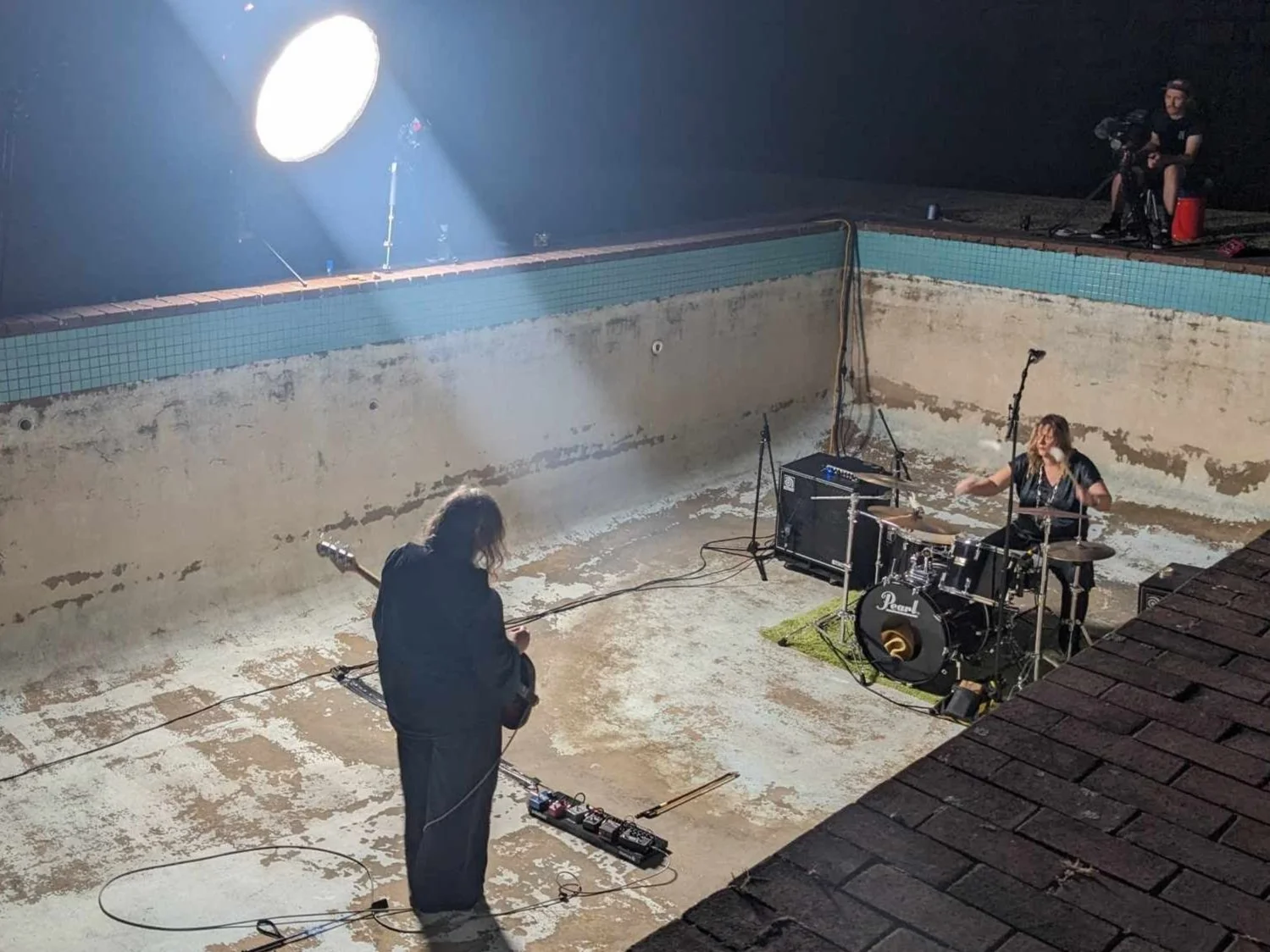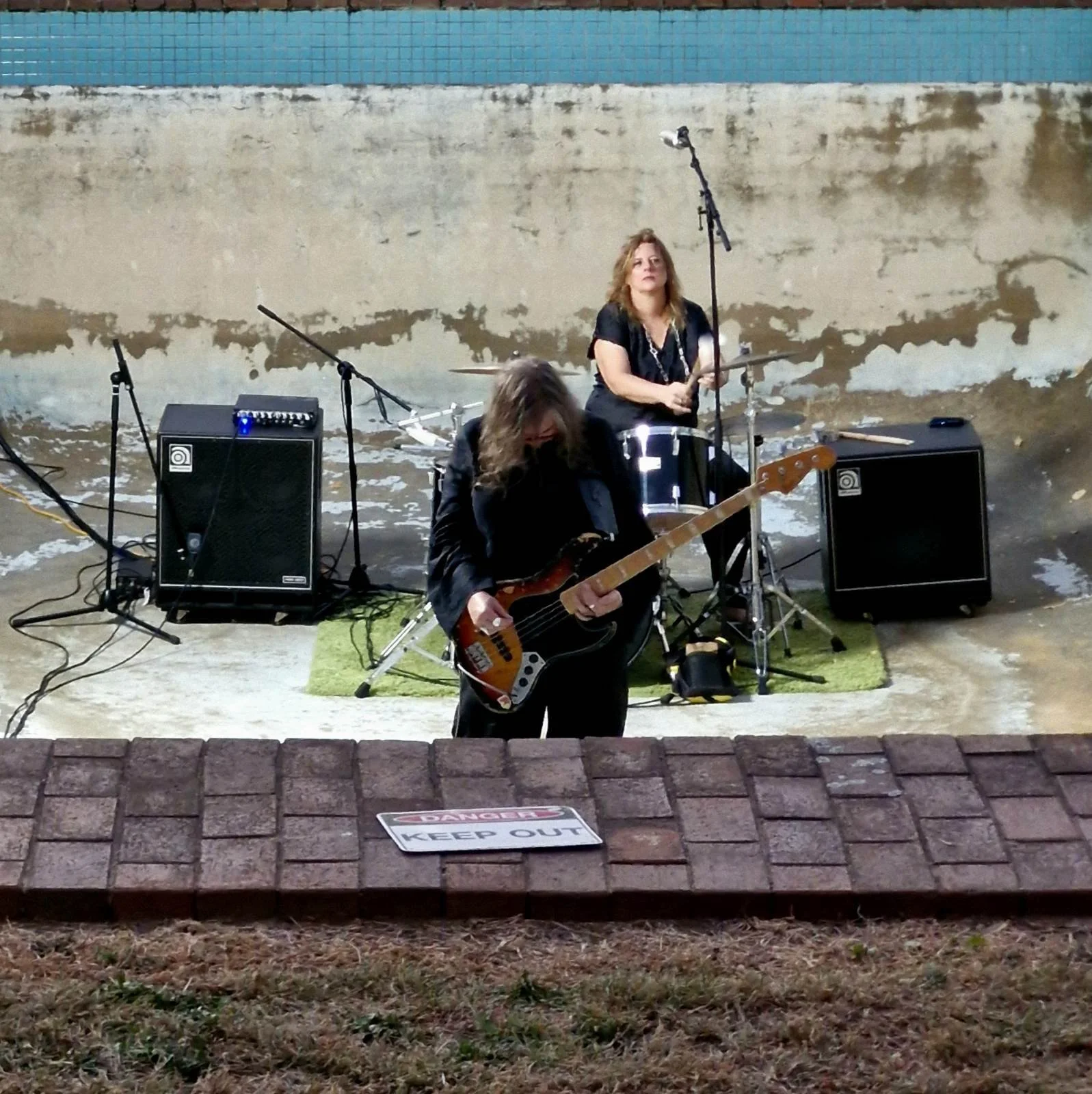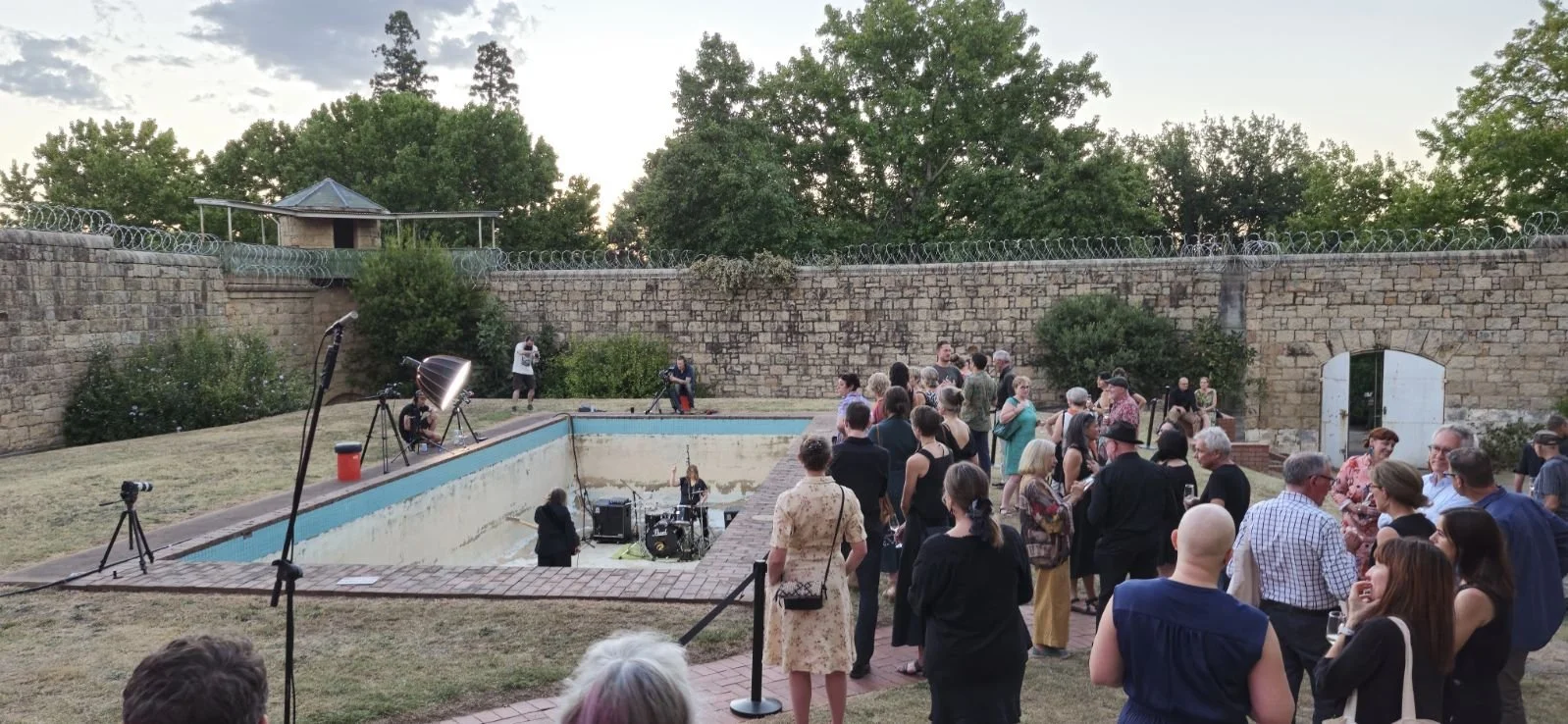FREESTYLE: Tina Havelock Stevens with Cat Hope: A conversation
Photo by Karl Ockelford
FREESTYLE
Live drum and bass performance/video/audio work.
Tina Havelock Stevens with Cat Hope.
Site 11: Abandoned swimming pool, pool courtyard the Old Beechworth Gaol, Sydney Road, Beechworth.
Beechworth Bienale, March 2024.
An interview between Cat Hope and Tina Havelock Stevens in April, 2024.
CH: FREESTYLE is a work for drummer and bassist, you and me, performed and videoed in an empty pool in the grounds of a historic prison. How did you come to the idea of performing in a pool? And can you tell me a little about the name?
THS: Beechworth Biennale is brand new and Nina Machielse Hunt, the Artistic Director, basically posted a bunch of incredible sites as part of an expression of interest process. I didn’t really look at the others, once I saw the empty outdoor pool and that it was inside a disused prison I got my motion on. I had no idea where Beechworth was. Charged environments get to me, I mean why is there a pool in the gaol? And gaols? I wouldn’t want to be incarcerated. I remember when I was about 19 visiting a friend who decided to experience gaol for three days over some driving fines. The air was thick. I remember saying to other friends at the time ‘I can really feel that this is a gaol’ and they were like ‘shut up’.
I’ve always been obsessed by empty pools – especially after my cousin told me a story in the eighties about how he and his friends were guerrilla skateboarding in empty suburban pools in Adelaide. I just watched this documentary about skating pools. Also an empty pool that once had a life scratches my western malaise. There’s also something about breathing – not something you can do when the pool is full. I also of course knew the sound would be spectacular and particular. Surfaces. Shapes. Textures. Weather (it was hot). A spontaneous composition for that time and place that needed you and your noise bass as accompaniment, a durational swim in the pool for us just below the earth’s surface.
So yeh FREESTYLE as a title has multifarious meanings. I like my entendres! There’s the swimming style and then there’s you and I freestyling, I mean we’ve only played together about 4 times, apart from me drumming in your noise opera, and a curious few days jamming and wine tasting at Gabriella Smart’s pad with Lisa MacKinney.
CH We also did a remote video work, where each of us videod ourselves played in our homes, and you edited that footage together, and that was then shown at a show in Home@735 Gallery in Sydney in 2016. I remember that Brian Ritchie introduced us to each other, after we’d both performed in MoFo in subsequent years – a classic ‘you need to meet this person..’. He was right!
This idea had resonance for me because I was a competitive swimmer in my pre and early teen years, a thing that started when I lived in Malaysia and continued when my family moved from there to Perth in the late 1970s. I trained 6 mornings, 3 afternoons each week! I was surprisingly disciplined in those days. My specialisation was breastroke, not freestyle.
Photo: Karl Ockelford
THS: FREESTYLE is absolute improvisation. Then there’s the fact that a gaol is the antithesis of FREE. Anyway back to the pool. It brings up all sorts of macabre visions … Apparently it was for exercise. The high granite fence surrounding the gaol has fresh razor wire on it which glints in the sun. Keeping people out? Richard Iskov (very much a local and who filmed the performance) told me that he heard that people would throw bottles of whiskey over the fence for the prisoners and of course they wouldn’t smash if they landed in water in the pool. The gaol, as we found out after performing, closed in 2004.
The other thing is, I like being involved with beginnings (like the Biennale). I seem to have performed at a few openings and closings. I’d also wanted to do another performance with you, and it just seemed right … and it was. The drums and bass just emanated out of that charged space. It was an uncluttered experience.
CH: I know what you mean – we met there, we set up, we played. It was easy. It was very hot but that kind of added to this uncluttered vibe, it slowed things down. Being an empty pool reminded me that we have both worked with water in some way in our own work. I made a performance art piece where I would undertake ‘stationary swimming’ in civic pools as a kind of installation – those shallow ones out the front of buildings. Never At Sea is a composition that attempts to describe being in water. And I know you have drummed underwater! What is behind your interest in water do you think?
THS: There’s not a reasoning that I can really theorise. I know I really am drawn to it. It’s just one of those things. I also swam a lot as a kid. My hair even turned green from the chlorine.
CH: Ha ha! My brother’s hair, which was blond, also did that! An image I won’t forget!
THS: I grew up in Sydney, we liked to go to the beach, my Dad was a rock fisherman and there was a river at my Uncles farm. Rain made me feel cosy.
So ok I do love water. I like looking at it and being in it (not rain unless I’m somewhere tropical) It’s a particular habitat and a mood changer. I’m made works with storms like Thunderhead, and the sea Beats of Darkness, and rivers The Rapids and I’ve got a bunch of waterfalls ready to go. I mean drumming underwater in the Derwent River for Mona Foma back in 2013 is defintely watery. The elements are powerful. Humans can’t control most water. I remember everyone talking about the drought when I was a child and how it was affecting my Uncles farm. The place was dry and full of locusts. Now it’s about floods. Water doesn’t need us.
CH: No, it doesn’t, thats true. I find the way FREESTYLE works toward video through performance fascinating. I enjoyed being in the edit studio with you and the editor, putting together the film to show for the rest of the festival, later in the night of the gig. It felt very natural, the way that came together. Can you describe the link between music and video for you? I know sometimes you play with video you've made, and other times, the video is the only part of the work. FREESTYLE, like other works of yours, starts as a performance, but then lives on as a video.
THS: The link between music and video is about the unknown. However in my practice it’s more than experimental documentation… it’s the coalescence of my existence as an observational cinematographer/ director and musician and how I’ve segued into a visual art and performance practice. My stylistic preference for both is improvisation. In the sense you can’t know what the work is really going to sound and/or look like, and you can see the shifts between the pool and us. It’s exciting and sometimes just strange watching it back and being surprised by the performative and the unpredictable. I’d shoot it myself if I could, and I have done that by just setting the camera up on the tripod, but I can’t get my true eyeball behind it and it’s doing too many jobs in the end. It would screw with my flow.
Photo: Evgeny Postnikov
CH: I was interested in that - your preparedness to give away the editing to someone else in this work. Do you usually do this?
THS: Nope and I don’t think I have given it away. It was great to get the fast turnaround done so that it could be screening on site at the pool just over 12 hours after we’d performed, but now that I’ve sat with it I know it needs a re-edit from the inside. I’d given minimal direction and knew that there needed to be multi cam and some drone shots for location. I had a gut feel that Richard would do a good job and his perspective was great. I think it’s a supercool performance piece, the drum mix needs to come up a bit though as we thought. Anyway the work will get its first other outing at a show I was asked to curate In Sydney, opening May 2 at Schmick Gallery in Chinatown.
I really didn’t think about the cameras at all which is the benefit of handing jobs over. So yeh it’s psychological and of course there’s a relationship to experimental film and a history with performance video. I was fairly obsessed with Andy Warhol’s Sleep film when I discovered it. I loved the idea of filming John Giorno (another one of my favourite artists) asleep. He’d wake up and Warhol would be gone and there’d just be empty film boxes strewn around. I spent years filming people observationally for various documentaries and series. Now sometimes I’m the subject, and, in this case, you are too.
Anyway it’s one way of capturing truth in motion.
And yes, sometimes I drum my videos live, another immediate read of an impression. I just like to keep on layering, being mercurial. It also keeps the relationship to the work very much alive.
CH: This link between FREESTYLE – improvising music performance and documentary film making, inside a goal that is now more or less a public space - there are some interesting tensions there. I see improvisation as a key part of your practice. I manage to perform both written and improvised work, even my notated composition has improvisation in it somehow, so i consider key to mine too. How do you relate to improvisation across the two mediums of video and music?
THS: Sticks, cameras whatever, I apply myself in the same way. I can do rehearsed formalised creations but it’s not so fun, and gives me anxiety. I like the element of the loose, of instant human decisions being made, of hearing things you know have come out of the blue. This is when I feel like the camera, or sticks are just an extension of my body and my way of seeing and being.
CH: It's great playing with drums and bass as soloists playing together. It kind of subverts the pattern found in bands, where they have a role as a back-up or support to other instruments. What is your perspective on the role of drums in music more broadly?
THS: Yeh I love it. The engine room goes rogue. I think I just got bored with drumming up the back of a band playing stop start tunes. I was totally fine in my first band Plug Uglies, that was a total adventure, with incredible people but then I got itchy with other bands. I think I felt like I was holding time for egos and not getting treated that well really. So fuck that. Maybe Plug Uglies was just the best band. I should mention The Mumps though with Liberty Kerr, that was great for a while last decade, but we dissolved and now with sustained irregularity sporadically improvise as a duo together which we both prefer. I feel the disconnection of souls when I see the drummer is a million miles up the back and no one else in the band even looks at them. I guess it’s a great job if you’re getting paid or you’re a session musician and that’s your bag. It’s just not my thing. I needed to feel more in my skin, but I still respect that vibe if the drummer is happy.
I love electronic music too so I’m into programmed beats, they can seriously kick but if a human is going to play them then I like to see that flow, involvement, the connection with what’s around them. They’re a great instrument - so visceral - but then instruments all are really. I don’t practice which again keeps everything fresh and reactive to the moment. I only play when there’s pools to improvise in and stuff comes up. This week I’m drumming a 15 minute improv with Chloe Kim for the MCA.
PhotoL Karl Ockelford
CH: I don’t practice bass either - I like to keep it in the live moment. Most of my previous practice came out of writing songs on the bass anyway, and I do that rarely now. You often speak of 'drumming' things, rather than drumming in, on, or at them. Can you tell me a bit about your decision to refer to your work this way?
THS: I guess it’s about getting inside where you are and knowing you’re going to play whatever the site informs you or object or whatever…maybe it’s what the ghosts tell you. There’s definitely some animist thinking in there too. It’s about making an instant soundtrack for that time and place …an acknowledgement of its existence…like trusting the space you go into, not overthinking and leaving without making a mess. I do see drums as a conduit. I’ve made them the object – they draw attention to things that have happened or are happening, histories. This time your bass did that too. By the way who was following who? It sounded fantastic.
CH: Who knows, it is quite circular – like drawing a circle – someone starts, there is a trace and soon you don’t know who is the starter or the tracer and it goes in all directions. Sometimes we link up rhythmically, but that always starts - and ends - spontaneously, I could never tell you who started it. It’s like aspontaneous improvisation that starts over and over again. There is a sense of flow which I think the audience can really participate in.
FREESTYLE was commissioned by the Inaugural Beechworth Biennale, which took place across the town of Beechworth, Victoria in March 2024.
FREESTYLE was filmed in the pool at Old Beechworth Goal between 7 and 8.30pm on 9th March, and shown as a film installation thereafter.
The film FREESTYLE is showing at the “Astronomical (Pisces)” show curated by Tina at Schmick Contemporary in Chinatown, Sydney from May 2, 2024.




